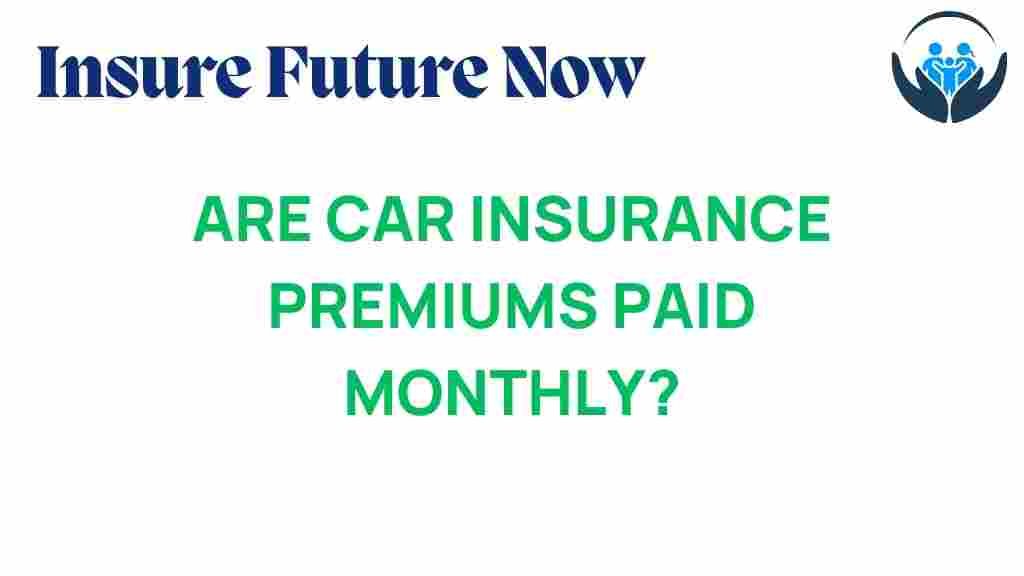Are Car Insurance Premiums Paid Monthly? Unlocking the Truth Behind Payment Options
When it comes to managing your finances, understanding your car insurance premiums is crucial. One question that often arises is whether these premiums can be paid on a monthly basis. The answer is yes, but there’s more to the story. This article will explore the various insurance options available, discussing payment plans, budgeting strategies, and financial planning to help you make informed decisions about your auto insurance needs.
The Basics of Car Insurance Premiums
Car insurance premiums are the amounts you pay for your auto insurance coverage. These premiums can vary based on several factors, including your driving history, the type of vehicle you drive, your location, and the coverage options you choose. Understanding how premiums work is essential for effective policy management.
Payment Options for Car Insurance Premiums
One of the most common ways to pay car insurance premiums is through monthly payments. However, insurers also provide several other options. Here’s a breakdown of the typical payment plans:
- Monthly Payments: This option allows you to spread your premium costs over 12 months. It’s ideal for those who prefer smaller, manageable payments.
- Quarterly Payments: Some insurers offer a quarterly payment plan, where you pay your premium every three months.
- Annual Payments: Paying your premium in a lump sum upfront is often the most economical choice, as many insurers offer discounts for this method.
- Biannual Payments: Similar to quarterly payments, but you pay every six months.
Monthly Payments: Pros and Cons
Choosing to pay your car insurance premiums monthly has its advantages and disadvantages. Here’s a closer look:
Pros:
- Budget-Friendly: Monthly payments allow for better cash flow management, fitting into most monthly budgets.
- Accessibility: Easier for those who may not have the funds to pay a larger premium at once.
- Flexibility: Some insurers allow changes to your policy mid-term, accommodating life changes.
Cons:
- Higher Overall Cost: Monthly payment plans often come with higher overall costs due to added fees or interest.
- Risk of Lapse: Missing a payment can lead to policy cancellation or lapse in coverage.
- Limited Discounts: Many discounts are only available for those who pay annually.
Choosing the Right Payment Plan
To select the best payment option for your car insurance premiums, consider the following factors:
- Your Financial Situation: Assess your monthly income and expenses to determine what you can afford.
- Type of Coverage Needed: Higher coverage may require larger premiums, affecting your payment choice.
- Insurance Provider Policies: Different providers have different discount structures; inquire about available discounts based on your payment method.
Budgeting for Car Insurance Premiums
Effective budgeting is key to managing your auto insurance costs. Here are some tips to help you budget for your insurance premiums:
- Assess Your Needs: Determine the coverage you require based on your vehicle and driving habits.
- Shop Around: Compare quotes from various providers to find the best rate.
- Account for Increases: Anticipate potential increases in your premiums and plan for them in your budget.
- Set Aside Funds: If you choose an annual payment plan, consider saving a small amount each month towards your premium.
Financial Planning and Consumer Awareness
Being financially aware is essential when it comes to managing your car insurance premiums. Here are some key points to consider:
- Understand Your Policy: Read and understand the terms of your policy to avoid surprises.
- Stay Informed: Keep up with changes in insurance laws and regulations that may affect your premiums.
- Evaluate Your Coverage Regularly: Review your policy annually to ensure it meets your current needs.
Troubleshooting Common Issues with Payment Plans
Sometimes, issues can arise with payment plans for your car insurance premiums. Here are some common problems and how to troubleshoot them:
Missed Payments
If you miss a payment, contact your insurer immediately. Many companies offer a grace period for late payments. If you’ve missed multiple payments, you may need to reinstate your policy, which could incur additional fees.
Increased Premiums
If you notice an unexpected increase in your premiums, reach out to your insurer for clarification. They can explain any changes in your risk profile or coverage that may have caused the increase.
Difficulty Managing Payments
If you find it challenging to keep up with monthly payments, consider switching to a quarterly or annual payment plan. Discuss your options with your provider to find a more manageable solution.
Conclusion
In summary, car insurance premiums can be paid monthly, but this payment option comes with its own set of pros and cons. Understanding these can help you make informed decisions about your insurance options and payment plans. Effective budgeting and financial planning are essential for managing your auto insurance costs. Remember to stay informed and proactive about your policy management to ensure you get the best coverage for your needs. For more information on managing your car insurance effectively, check out this comprehensive guide.
By being a savvy consumer and understanding your options, you can make the most of your auto insurance and ensure you are adequately protected on the road.
This article is in the category Rates and created by InsureFutureNow Team
